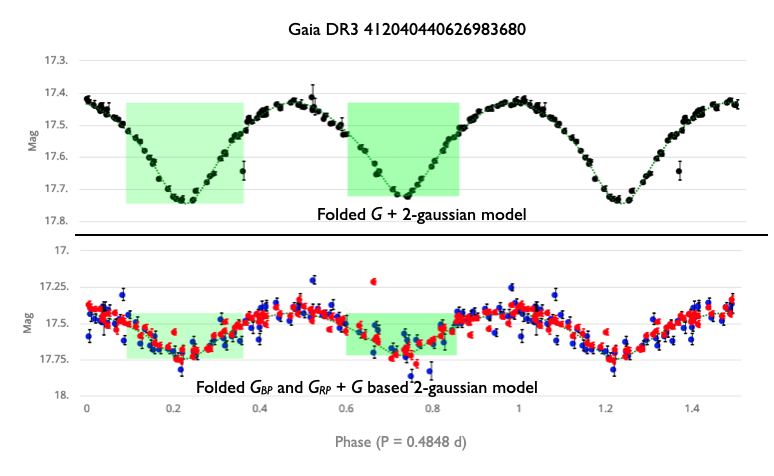10.7.5 Quality assessment and validation
Verification



Three examples of EB folded light curves with their corresponding two-Gaussian models are shown in Figures 10.10 to 10.12, illustrating typical cases of EA-, EB-, and EW-type eclipsing binaries, respectively. The -band folded light curves are shown in the top panel of each figure, while the and folded light curves are shown in the bottom panels with the -band based model superimposed for illustration purposes.

The distribution of the global ranking of all the Gaia DR3 eclipsing binaries is shown in Figure 10.13. For comparison, the distribution of the cross-matches of known EBs from the literature, which amount to nearly 528 000 sources, is also shown in the figure.

The distribution in the observational Hertzsprung–Russell diagram of the 521 000 Gaia DR3 EBs with relative parallax uncertainties better than 20 % is displayed in red in Figure 10.14. It is consistent with the distribution of known eclipsing binaries from the literature, shown in blue in the figure.
Validation
 |
 |

The validation of the EB periods published in Gaia DR3 can be estimated by their comparison with the periods found in the literature for the sub-sample of nearly 530 000 sources that have a cross-match with known EBs. In Figure 10.15, the left panel reveals a similar distribution between the Gaia DR3 periods and the literature ones. The right panel directly compares the Gaia DR3 periods with the periods published in the literature, showing that the majority of them are either similar (82 %) or within a factor of two (7 %) between one another. The period distributions of the subsets that are classified as EA-, EB- and EW-type in the literature are shown in Figure 10.16. As expected, EA-type binaries dominate the long-period range while EW-type binaries are mainly found at periods below one day.